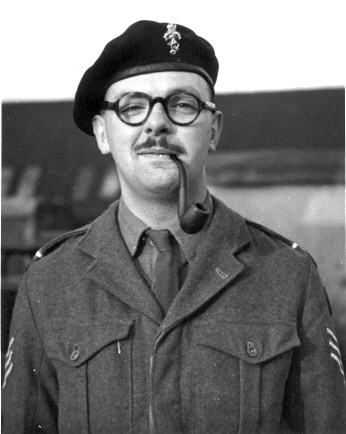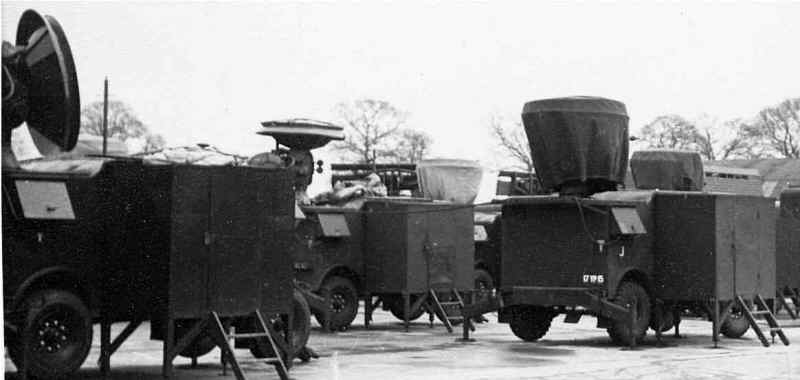The iconoclast confronts the establishment
by David Birt
 Having
reported to Blandford Camp in Dorset for “basic training” (=square-bashing), and
had my hair shaved off, I learned that although I had a C&G Diploma in
Telecommunications, my Army trade would be either that of a welder, or “vehicle
and plant”. I knew that the Army had at least radio sets, and attempted to
negotiate a change of trade. However, I was told that since my trade had already
been allocated, that was it. My platoon officer seemed quite a reasonable man,
so I asked if I could take a trade-test as a telecomms mechanic? “Oh but you
can’t take a trade test without going on a course, and you can’t go on a course
unless you have been allocated that trade”. “Where is the Army regulation which
says that?” I enquired. He didn’t know, but promised to look into the matter.
Two weeks later, I was given a pass to go for a telecomms trade-test at a
civilian-run workshop in Cosham, near Portsmouth. I sailed through that with
marks of 98%, but it became apparent that the Army had radar sets as well as
radios. I persuaded the boss to allow me to take a radar trade-test. That was a
bit more complicated because it required some knowledge of specific equipments.
It was agreed that I could spend a couple of days in the library studying
service manuals. My marks for the test were only 85% this time, but well above
the pass mark. The upshot was that I returned to Blandford qualified as a
telecomms mechanic, and as a radar mechanic. The Army was very cross with
this man with two trades who hadn’t been on a course, made me do my
square-bashing all over again, and posted me to an Army radar workshop at
Longniddry in the frozen wilds of Scotland. Only when I arrived there did I
learn that there was an Army radar school at Arborfield near Reading. I applied
to go on a 47-week course there (LAS11), managed to get through the selection
process, and qualified as a Leading Artisan Sergeant: a position which was as
high as you could go as a National Service NCO. 23068117 – the number you never
forget!
Having
reported to Blandford Camp in Dorset for “basic training” (=square-bashing), and
had my hair shaved off, I learned that although I had a C&G Diploma in
Telecommunications, my Army trade would be either that of a welder, or “vehicle
and plant”. I knew that the Army had at least radio sets, and attempted to
negotiate a change of trade. However, I was told that since my trade had already
been allocated, that was it. My platoon officer seemed quite a reasonable man,
so I asked if I could take a trade-test as a telecomms mechanic? “Oh but you
can’t take a trade test without going on a course, and you can’t go on a course
unless you have been allocated that trade”. “Where is the Army regulation which
says that?” I enquired. He didn’t know, but promised to look into the matter.
Two weeks later, I was given a pass to go for a telecomms trade-test at a
civilian-run workshop in Cosham, near Portsmouth. I sailed through that with
marks of 98%, but it became apparent that the Army had radar sets as well as
radios. I persuaded the boss to allow me to take a radar trade-test. That was a
bit more complicated because it required some knowledge of specific equipments.
It was agreed that I could spend a couple of days in the library studying
service manuals. My marks for the test were only 85% this time, but well above
the pass mark. The upshot was that I returned to Blandford qualified as a
telecomms mechanic, and as a radar mechanic. The Army was very cross with
this man with two trades who hadn’t been on a course, made me do my
square-bashing all over again, and posted me to an Army radar workshop at
Longniddry in the frozen wilds of Scotland. Only when I arrived there did I
learn that there was an Army radar school at Arborfield near Reading. I applied
to go on a 47-week course there (LAS11), managed to get through the selection
process, and qualified as a Leading Artisan Sergeant: a position which was as
high as you could go as a National Service NCO. 23068117 – the number you never
forget!
Get a haircut! (The things that really matter in the Army)
The regime in the workshops at Longniddry was fairly laid-back and relatively non-regimental. However, there was an annual inspection by a visiting Brigadier. That was preceded by a period of panic when almost everything was whitewashed, except coal which had to be painted black. Some of my hair had begun to grow back by then, and was on the borderline of being out of spec.! There was a long queue for the barbers, so I decided to have a go with my shaver. My barrack-room companions were of the unanimous opinion “you’ll never get away with that!” – yes I will. Come the great day, there we all were stood to attention on parade, and round came the Brigadier with his entourage. He himself couldn’t have cared less, and just walked past me: I think he wanted his lunch. However, towards the back of the entourage was a frightfully keen newly commissioned officer. “What about this man’s hair!” so they all come back and start poking with the sticks carried for the purpose. At the rear of the entourage is a Sergeant Major equipped with black book: Name? Birt. He clearly thought I had uttered my first name ‘Bert’ and was being facetious. Consequently I was instantly marched off at “feet won’t touch the ground” speed to a cell in the guardroom. When it was discovered that my name actually was Birt, the Army was sufficiently embarrassed not to press charges. So I did actually get away with it!
No 5 Training Battalion, Arborfield
I stayed at Arborfield for the rest of my sentence as an Instructor in Radar equipments. During that time, I built a 120 Watt audio amplifier made out of ex-radar-set parts (four 807 valves in parallel push-pull) and with a friend put together a public address system which (modesty aside) was not bad at all. This was used for garrison sports days and the like, and a visiting Brigadier from Aldershot was so impressed with the sound quality that I was asked to provide the service at other Army venues, and allocated a truck with driver for the purpose. This was good, as it got me out of stamping about at quite a few major parades – much to the chagrin of some of the “military minds”! Oh yes, that FM tuner came with me to Arborfield, and always had a substantial audience for the essential Goon Show on Wednesday evenings.
A principal radar equipment was known as the 3Mk7, a 10cm single-dish target-locking radar built by BTH around 1942, and it was stuffed full of Blumlein. The delay-line pulse modulator for the magnetron, and of course many instances of the “long-tailed pair” circuit configuration invented by Blumlein. In this case, it really was a long-tailed pair in more ways that one, for the “tail” consisted of a physically-long string of series-connected resistors going down to –5kV! To facilitate instruction in a less-cramped space than that available in the cabin, we extended the aerial feeder (which was coax) with a long-ish section of waveguide. The main crates could then be placed within the workshop, leaving the cabin and dish outside in the rain.

The IRA raid
I was actually on leave when this happened, but was summoned back by telegram. A van-load of the IRA had driven up to the main gate, tied up the guard commander, broken into the armoury, and stolen some ammunition and a few rifles. The civilian police apprehended the van only a few miles down the road by a routine spot check.
Security was a problem because only hedges marked the extensive perimeter of the site. The Army’s solution was to station soldiers every few yards round the perimeter, day and night. This meant that on average, every soldier found himself on guard duty every two or three nights. One effect of this sleep deprivation was that lecturers had an impossible task because the majority of the class would be fast asleep. Morale took a dive!
The “HATE” campaigns
George Orwell’s famous film “1984” had only recently been shown for the first time on TV. That is where the idea of the release of frustration by the staging of Hate Campaigns came from. The barracks comprised a large brick-built H-shaped building. How it would start was like this: someone would lean out of a window and shout, “what do we hate? We hate the Army: HATE HATE HATE!”
The crescendo soon built up into a deafening noise accompanied by banging mess tins, or any such thing which would enhance the noise level. In parallel with this, the word HATE would subtly appear on almost everything! If you lifted a loo seat, it would probably have HATE written on the underside. Pick up a blackboard rubber, and there was the word again. One group of conscripts was required to plant tulips outside the barber’s hut. I was there long enough to watch them come up the following Spring in perfect formation spelling HATE in vivid red! Such was the din on these several ‘riot’ occasions that it eventually reached the ears of the Brigadier who lived some 3 miles away. An enquiry was instigated and the buck started to be passed down the line. It stopped at a group of some 12 NCOs who were billeted in the main block rather than the Sergeants’ (pronounced saahn’s) Mess, and it was alleged we should have stopped these riots! Little did they know we were enthusiastic participants! The establishment couldn’t actually think of a way in which we could be charged, so instead we all got sent on a beat-you-up regimental course at Bordon. So my “sentence” ended as it had begun with square-bashing! The longed-for end was in a way something of an anticlimax: I just tied my kit bag on the back of my bike and rode off – that was it!